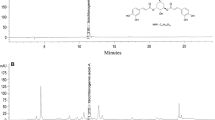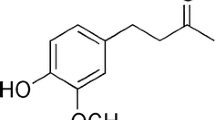Abstract
Alcoholic liver disease (ALD) develops as a consequence of priming and sensitizing mechanisms rendered by cross-interactions of primary mechanistic factors and secondary risk factors. Liver damage due to consumption of alcohol may be caused by oxygen radicals such as superoxide and hydroxyl radicals, generated during the metabolism of ethanol by the microsomal oxidizing system. Lecithin, an important class of phospholipids contains choline, which is considered as lipotropic factor. The effects of this lecithin as a hepatoprotective drug on body weight and antioxidant status of ethanol-exposed rats were studied. The results were compared with the effects of tocopheryl acetate. From the present study, it can be concluded that ethanol-induced stress can be partly prevented by tocopheryl acetate, and showed best result. Abstination from alcohol also involved for little hepatic regeneration. Supplementation of lecithin showed better effect compared to abstination from alcohol on reversing the effect of ethanol induced liver damage in the present study. Moreover, preventive measures were found to be better than curative treatment. Antioxidants are likely to provide beneficial effects on hepatocyes via desensitization against oxidant stress while inhibiting primary mechanism for expression of proinflammatory and cytotoxic mediators. However, abstinence from alcohol, proper nutrition, and supplementation of antioxidants, vitamins and hepatoprotective drugs are some of the therapeutic options.
Similar content being viewed by others
References
Tsukamoto, H. and Lu, S. C. (2001). Current concepts in the pathogenesis of alcoholic liver injury. FASEB J. 15, 1335–1349.
Finkelstein, J.D. (1990). Methionine metabolism in mammals. J. Nutr. Biochem. 1, 228–237.
Mato, J.M., Alvarez, L., Corrales, F. and Pajares, M.A. (1994). S-adenosylmethionine and the liver. In: The liver biology and Pathology. Eds., Arias, I.M., Boyer, J.L., Fausto, N., Jakoby, W.B., Schachter, D.A. and Shafritz, D.A. Raven Press, New York; pp. 461–470.
Mato, J.M., Alvarez, L., Oritz, P. and Pajares, M.A. (1997). S-adenosylmethionine synthesis: molecular mechanisms and clinical implications. Pharmacol. Ther. 73, 265–280.
Hoffman, D.R., Marion, D.W., Cornatzer, W.E. and Duerre, J.A. (1980). S-adenosylmethionine and S-adenosylhomocysteine metabolism in isolated rat liver. Effects of L-methionine, L-homocysteine, and adenosine. J. Biol. Chem. 255, 10822–10827.
Lu, S.C. (1998). Regulation of hepatic glutathione synthesis. Semin. Liv. Dis. 18, 331–343.
Lieber, C.S., Casini, A., DeCarli, L.M., Kim, C.I., Lowe, N., Saski, R. and Leo, M.A. (1990). S-adenosyl-L-methionine attenuates alcohol-induced liver injury in the baboon. Hepatol. 11, 165–172.
Lieber, C.S., Robins, S.J. and Leo, M.A. (1994). Hepatic phosphaidylethanolamine methyl transferase activity is decreased by ethanol and increased by phosphtidylcholine. Alc. Clin. Exp. Res. 18, 592–595.
Package of Practices Recommendation (2001). Veterinary & Animal Husbandary Department, Kerala Agriculture University, Mannuthy, Thrissur.
Lowry, O.H., Rosenbourgh, N.J., Farr, A.L. and Randall, R.J. (1951). Protein measurement with folin phenol reagent. J. Biol. Chem. 193, 265–275.
Roe, J.H. and Kuether, C.A. (1943). The determination of ascorbic acid in whole blood and urine through the 2,4-dinitrophenyl hydrazine derivative of dehydro ascorbic acid. J. Biol. Chem. 147, 399–401.
Sinnhuber, R.O., Yu, T.C. and Yu, T.C. (1958). Characterization of the red pigment formed in the thiobarbituric acid determination of oxidative rancidity. Food Res. 23, 626–630.
Ellman, G.L. (1959). The sulphydryl groups. Arch. Biochem. Biophys. 32, 70–77.
Beers, R.F. and Sizer, I.W. (1952). A spectrophotometric method for measuring the breakdown of hydrogen peroxides by catalase. J. Biol. Chem. 195, 133–140.
Nelson, D.P. and Kiesow, L.A. (1972). Enthalpy of decomposition of hydrogen peroxide by catalase at 25°C (with molar extinction coefficients of H2O2 solutions in the UV. Anal. Biochem. 49, 474–478.
Goldberg, M.D. and Spooner, J.R. (1983). Glutathione reductase. In: Methods Enzyme Analysis. Eds. Bergmayer, H.U., Bergmayer J. and Grabi M. Academic Press, Inc., Florida; Vol. III, 3rd edn. pp. 258–265.
Habig, W.H., Pabst, M.J. and Jakoby, W.B. (1974). Glutathione S-transferase, the first enzymatic step in mercapturic acid formation. J. Biol. Chem. 249, 7130–7139.
Paglia, D.E. and Valentione, W.N. (1967). Studies on the quantitative and qualitative characterisation of erythrocyte glutathione peroxides. J. Lab. Clin. Med. 70, 158–159.
Marklund, S. and Marklund, G. (1974). Involvement of superoxide radical in the auto oxidation pyrogallol and a convenient assay for superoxide dismutase. Eur. J. Biochem. 47, 469–474.
Das, S.K. and Vasudevan, D.M. (2005). Effect of ethanol on liver antioxidant defense systems: a dose dependent study. Ind. J. Clin. Biochem. 20 (1), 79–83.
McClain, C., Hill, D., Schmidt, J. and Diehl, A.M. (2001). Cytokines and alcoholic liver disease. Semin. Liv. Dis. 13, 170–182.
Mari, M., Wu, D., Nieto, N. and Cederbaum, A.I. (2001). CYP2E1-dependent toxicity and upregulation of antioxidant genes. J. Biomed. Sci. 8 (1), 52–55.
Campos, R., Garrido, A., Guerra, R. and Valenzuela, A. (1989). Silybin dihemisuccinate protects against glutathione depletion and lipid peroxidation induced by acetaminophen on rat liver. Planta. Med. 55, 417–419.
Valenzuela, A., Lagos, C., Schimdt, K. and Videla, K. (1985). Silymarin protection against hepatic lipid peroxidation induced by acute ethanol intoxication in the rat. Biochem. Pharmacol. 3, 2209–2212.
Dinu, V. and Zamfir, O. (1991). Oxidative stress in ethanol intoxicated rats. Rev. Roum. Physiol. 28 (1–2), 63–67.
Chandra, R., Aneja, R., Rewal, C., Konduri, R., Dass, S.K. and Agarwal, S. (2000). An opium alkaloid-Papaverine ameliorates ethanol-induced hepatotoxicity: diminution of oxidative stress. Ind. J. Clin. Biochem. 15 (2), 155–160.
Aniya, Y. and Daido, A. (1994). Activation of microsomal glutathione S-transferase in tert-butyl hydroperoxide-induced oxidative stress of isolated rat liver. Jpn. J. Pharmacol. 66 (1), 123–130
Buettner, G.R. (1993). The pecking order of free radicals and antioxidants: lipid peroxidation, alpha tocopherol and ascorbate. Arch. Biochem. Biophys. 300, 535–543.
Maellaro, E., Casini, A.F., DelBello, B. and Comporti. (1990). Lipid peroxidation and antioxidant systems in the liver injury produced by glutathione depleting agents. Biochem. Pharmacol. 39 (10), 1513–1521.
Lieber, C.S., Leo, M.A., Mak, K.M., DeCarli, L.M. and Sato, S. (1985). Choline fails to prevent liver fibrosis in ethanol-fed baboons but causes toxicity. Hepatol. 5 (4), 561–572.
Lieber, C.S., DeCarli, L.M., Mak, K.M., Kim, C.I. and Leo, M.A. (1990). Attenuation of alcohol-induced hepatic fibrosis by polyunsaturated lecithin. Hepatol. 12 (6), 1390–1398.
Author information
Authors and Affiliations
Corresponding author
Rights and permissions
About this article
Cite this article
Das, S.K., Vasudevan, D.M. Effect of lecithin in the treatment of ethanol mediated free radical induced hepatotoxicity. Indian J Clin Biochem 21, 62–69 (2006). https://doi.org/10.1007/BF02913068
Issue Date:
DOI: https://doi.org/10.1007/BF02913068




